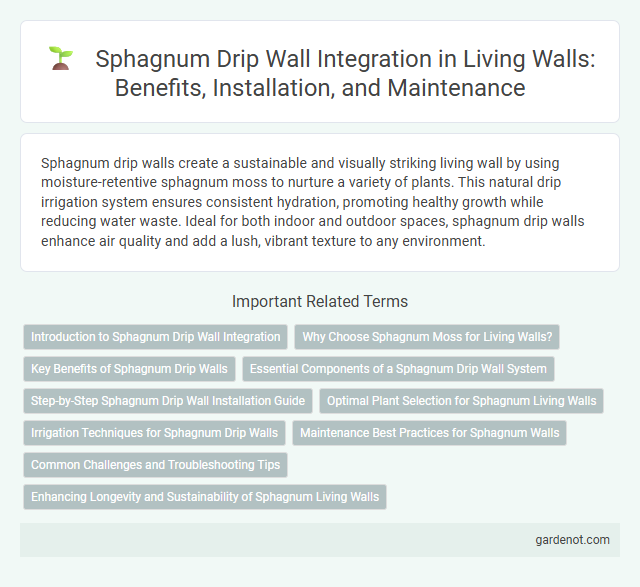Sphagnum drip walls create a sustainable and visually striking living wall by using moisture-retentive sphagnum moss to nurture a variety of plants. This natural drip irrigation system ensures consistent hydration, promoting healthy growth while reducing water waste. Ideal for both indoor and outdoor spaces, sphagnum drip walls enhance air quality and add a lush, vibrant texture to any environment.
Introduction to Sphagnum Drip Wall Integration
Sphagnum drip walls enhance indoor living spaces by integrating natural moisture regulation and air purification through sphagnum moss layers. This innovative living wall system optimizes humidity levels while supporting plant health with controlled water drip mechanisms. Incorporating sphagnum drip walls improves indoor air quality and contributes to sustainable, biophilic interior design solutions.
Why Choose Sphagnum Moss for Living Walls?
Sphagnum moss excels in living walls due to its superior water retention and natural air purification properties, creating a consistently humid microenvironment vital for plant health. Its lightweight and compressible structure supports vertical installations without adding excessive weight, minimizing structural load. The moss also inhibits mold growth while promoting beneficial microbial activity, enhancing the overall durability and sustainability of living wall systems.
Key Benefits of Sphagnum Drip Walls
Sphagnum drip walls provide superior moisture retention, creating an ideal microclimate that supports healthy plant growth and reduces maintenance requirements. Their natural antimicrobial properties inhibit mold and bacterial growth, promoting a cleaner and healthier environment. These living walls also enhance indoor air quality by filtering airborne pollutants and increasing humidity, contributing to improved well-being.
Essential Components of a Sphagnum Drip Wall System
A Sphagnum drip wall system relies on key components including a water reservoir, an efficient drip irrigation system, and a durable backing material to support the sphagnum moss. The reservoir ensures a consistent water supply, while the drip irrigation delivers moisture evenly, promoting optimal moss hydration and growth. A sturdy backing material provides structural support, enabling the moss to thrive vertically with minimal maintenance.
Step-by-Step Sphagnum Drip Wall Installation Guide
Install a Sphagnum drip wall by first mounting a waterproof backing board securely to the wall surface, ensuring proper support and moisture protection. Next, attach a drip irrigation system evenly across the backing to deliver consistent water flow to the Sphagnum moss centerpiece. Finally, layer and affix the Sphagnum moss in sections on a mesh or frame, allowing roots to embed while maintaining moisture with regular drip irrigation adjustments for optimal growth and longevity.
Optimal Plant Selection for Sphagnum Living Walls
Sphagnum drip walls thrive best with moisture-loving plants such as ferns, air plants (Tillandsia), and moss varieties that complement the high humidity environment. Selecting shade-tolerant species like Boston ferns (Nephrolepis exaltata) or maidenhair ferns (Adiantum) ensures sustained health and vibrant growth in low-light conditions typical of sphagnum living walls. Incorporating epiphytic orchids and bromeliads enhances biodiversity while maintaining the optimal hydration balance essential for sphagnum-based vertical gardens.
Irrigation Techniques for Sphagnum Drip Walls
Sphagnum drip walls utilize precise irrigation techniques that deliver moisture directly to the moss, ensuring optimal hydration without oversaturation. These systems often incorporate adjustable drip emitters and timers to maintain consistent water flow, promoting healthy growth and longevity. Automated irrigation reduces water waste and supports the delicate structure of sphagnum moss in vertical garden installations.
Maintenance Best Practices for Sphagnum Walls
Sphagnum drip walls require regular moisture monitoring to maintain optimal humidity levels essential for healthy moss growth. Cleaning drip emitters and ensuring proper water distribution prevent clogs and uneven hydration, which can cause brown patches or mold development. Routine inspection for pests and trimming of overgrown sections promote vigorous regeneration and longevity of the living wall system.
Common Challenges and Troubleshooting Tips
Sphagnum drip walls often face challenges such as uneven water distribution leading to dry patches and overwatering causing root rot. Regular inspection of the irrigation system and adjusting drip emitters ensures consistent moisture levels optimal for sphagnum moss growth. Addressing issues promptly with proper drainage and humidity control helps maintain healthy, vibrant living walls.
Enhancing Longevity and Sustainability of Sphagnum Living Walls
Sphagnum drip walls enhance the longevity and sustainability of living walls by providing consistent moisture through a controlled drip irrigation system that prevents overwatering and root rot. This method supports healthy sphagnum moss growth, which acts as a natural air purifier and moisture regulator, reducing the need for frequent maintenance and water consumption. Incorporating a sphagnum drip wall optimizes plant health and promotes eco-friendly urban green spaces with extended durability.
Sphagnum drip wall Infographic

 gardenot.com
gardenot.com